Lauren Dubick
- Problem Set #1
|
Part 1
|
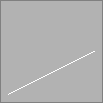 p1.dbn p1.dbn |
// lauren's line
paper 30
pen 0
line 7 7 93 50
|
| |
Create a program to draw a carefully chosen one line on a paper of your choice.
|
Part 2
|
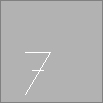 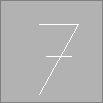 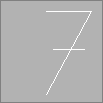 p2.dbn p2.dbn |
// lauren's 3 lines
paper 30
pen 0
set b 77
line (b/2) 7 b b
line (b/2) b b b
line ((b/2)+7) ((b/2)+7) (b-7) ((b/2)+7)
|
| |
Create a program that uses one variable as a means to control a set of 3 lines. Capture 3 instances of the graphic (A,B,C).
|
Part 3
|
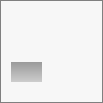 p3.dbn p3.dbn |
// lauren's rectangle
paper 3
repeat b 20 40
{
pen b
line 10 b 40 b
}
|
| |
Create a program to draw a single filled rectangle. Again, choose carefully.
|
Part 4
|
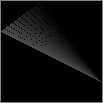 p4.dbn p4.dbn |
// lauren's triangle
paper 100
repeat X 0 120
{
pen Y
set Y (((X*3)/12)+ 70)
line 100 20 (X/3) Y
}
|
| |
Create a program to draw a single filled triangle. Use your good judgement.
|
Part 5
|
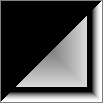 p5.dbn p5.dbn |
// lauren's triangle
paper 100
repeat X 0 50
{
smaller? X 15
{
pen (X*X)
}
notsmaller? X 15
{
pen (x)
}
line X X (100-X) (100-X)
line (100-x) (100-x) (100-X) X
line (100-X) X X X
}
|
| |
Think of all the ways you can draw a filled triangle, and choose one. Utilize the properties of the drawing method you choose, to create a single filled triangle.
|
Part 6
|
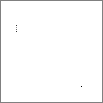 p6.dbn p6.dbn |
// lauren's dots
paper 0
set [15 70] 80
set [15 72] 60
set [15 74] 40
set [15 76] 80
set [80 15] 100
|
| |
Set 5 dots on a paper of your choice. Evoke an emotion with your choice in placement of dots.
|
Part 7
|
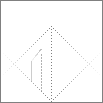 p7.dbn p7.dbn |
// lauren's dots
paper 0
repeat x 0 25
{
// bottom
set [(x*2) (50-(2*x))] (x*2)
set [((x*2)+50) ((x*2))] ((25-x)*2)
// vertical lines
set [50 (x*3)] 50
set [40 (10+((3*x)/2))] 30
set [30 (20+((x*5)/6))] 20
// top
set [(x*2) (25+(2*x))] (x*2)
set [(100-(x*2)) ((x*2)+25)] (x*2)
// left little diagonal
set [(((x*2)/5)+30) (40+(x/2))] x
}
|
| |
Create a representational picture (i.e. something that looks like something) using just 8 (at maximum) dotted lines.
|
Part 8
|
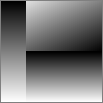 p8.dbn p8.dbn |
// lauren's pattern
paper 100
repeat X 0 100
{
repeat B 0 100
{
set [B (x/2)] X
set [X ((X/2)+B)] (100-B)
smaller? B 25
{
repeat C 0 100
{
set [B C] C
}
}
}
}
|
| |
Using a nested loop, fill the entire field with the value of some calculation that can be appreciated. Do not use the Line command.
|
Part 9
|
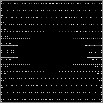 p9.dbn p9.dbn |
// lauren's pattern
paper 100
set x 7
repeat y 0 (100/x)
{
repeat z 0 (100/x)
{
set [(y*z) ((y+x)*7)] 40
set [(y*z) ((y+Z)*7)] 20
set [(100-(y*z)) ((y+x)*7)] 70
set [(100-(y*z)) ((y+Z)*7)] 10
set [(y*z) (100-((y+x)*7))] 40
set [(y*z) (100-((y+Z)*7))] 20
set [(100-(y*z)) (100-((y+x)*7))] 10
set [(100-(y*z)) (100-((y+x)*7))] 20
}
}
|
| |
Using a nested loop, create a stippled pattern of dots that can be enjoyed for its complexity. Do not use the Line command.
|
Part 10
|
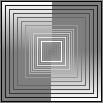 p10.dbn p10.dbn |
// lauren's object
paper 50
// bottom half
repeat x 0 50
{
repeat v 0 50
{
pen x
line (v+50) x 100 x
}
}
// tophalf
repeat y 0 50
{
repeat z 0 50
{
pen y
line 0 (100-y) z (100-y)
}
}
// squares
repeat b 15 25
{
set a (b*2)
pen a
line a a (100-a) a
line (100-a) a (100-a) (100-a)
line (100-a) (100-a) a (100-a)
line a (100-a) a a
}
repeat d 15 25
{
set c (d*4)
pen ((d-15)*10)
line c c (100-c) c
line (100-c) c (100-c) (100-c)
line (100-c) (100-c) c (100-c)
line c (100-c) c c
}
|
| |
Using the Line command, and a (few) nested loop, create an image that evokes a three-dimensional feeling through shading.
|
 p1.dbn
p1.dbn 

 p2.dbn
p2.dbn  p3.dbn
p3.dbn  p4.dbn
p4.dbn  p5.dbn
p5.dbn  p6.dbn
p6.dbn  p7.dbn
p7.dbn  p8.dbn
p8.dbn  p9.dbn
p9.dbn  p10.dbn
p10.dbn